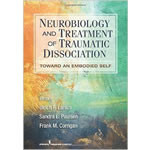
 Lanius, U. F., Paulsen, S. L., & Corrigan, F.M. (2014). Neurobiology and Treatment of Traumatic Dissociation: Toward and Embodied Self.
Lanius, U. F., Paulsen, S. L., & Corrigan, F.M. (2014). Neurobiology and Treatment of Traumatic Dissociation: Toward and Embodied Self.
Reviewed by: Anny Reyes, New York University
One can agree that research findings on the neurobiological underpinnings of psychopathology could help aid in forming successful interventions and treatments. However, there is a gap between science and practice. It is difficult to find a comprehensive integration of both research and clinical interventions in many psychopathological conditions such as traumatic stress syndromes and dissociation disorders. Dissociation is often explained in a dichotomous fashion, either in a psychoanalytic context or purely neurobiological, with no implications of a common ground. Neurobiology and Treatment of Traumatic Dissociation provides 22 chapters of integrative research and clinical applications written by various experts in the fields of affective and cognitive neuroscience, animal research, psychology, and psychiatry, among others.
The text is divided into two parts: the first part is focused on the neurobiology of dissociation and the second is dedicated to treatment and interventions. The first part of the book is aimed at providing the neurobiological framework behind traumatic dissociation that informs clinical practice and treatment. One of the main goals of the authors is to provide well-grounded research that could further advance the understanding of traumatic dissociation and create the missing dialogue between researchers and clinicians. The material in the first part of the book is very dense in neurobiology, neuroscience, and neuroendocrine terminology, which could present an obstacle for clinicians who do not have any neuroscience background. However, the authors provide explanations and definitions of many of the general concepts explored and they make occasional references to clinical terminology and treatment. It is noteworthy that the book is targeted at clinicians and researchers who are looking to further expand their expertise in traumatic dissociation.
The second part of the book is focused on treatment and integrating the research previously discussed. For each concept explored several options for treatment and intervention are provided, along with case examples and vignettes. The authors focus on the theoretical background of the treatments and not on step-by-step guidelines. Therefore, further reading is recommended if a clinician is interested in incorporating these interventions into their clinical practice. The editors did an exceptional job at putting together a comprehensive source of emerging research in the neurobiology of traumatic dissociation and stress.
Lanius, U. F., Paulsen, S. L., & Corrigan, F.M. (2014). Neurobiology and Treatment of Traumatic Dissociation: Toward and Embodied Self.
ISBN: 978-0-8261-0631-5.
Paperback. 510 pages. Includes: Index. Keywords: traumatic dissociation, neurobiology, integrative research.
